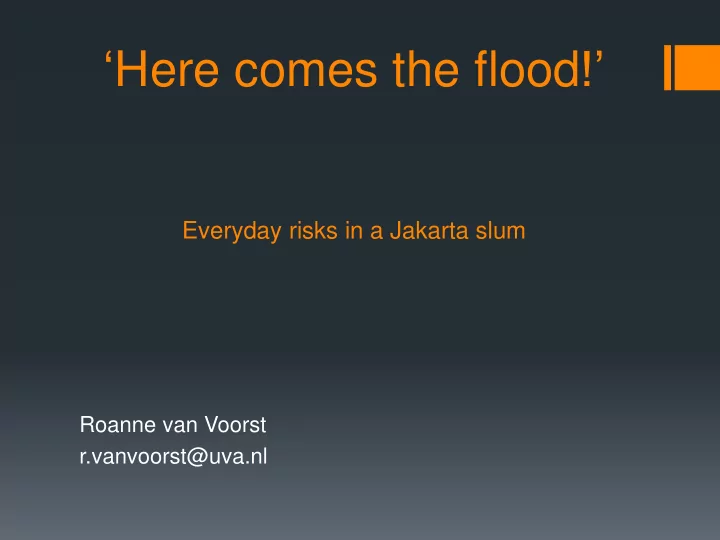

‘ Here comes the flood !’ Everyday risks in a Jakarta slum Roanne van Voorst r.vanvoorst@uva.nl
Large floods 1996, 2002, 2007, 2009, 2013, 2014….. ‘Small’ floods Several times each year, not everywhere . Consequences Economic losses Trauma Damage and loss of assets Reproduction of poverty Illness; injuries Death
Causes of floods City mismanagement & urbanization - Old infrastructure - Garbage - Many buildings, little greenery (soil absorbtion) Natural factors Rain, climate changes? ‘ Flood- policy’
Old infrastructure
Urbanization dynamics 1811: 47,000. Early twentieth century: 500,000. 2010: 10 million (official city population); metropolitan area of 20 million 2015: 17 million? Population growth per year 130,000 to 250,000 (World Bank, 2011). more extensive use of the built environment, more garbage clogging the sewerage system, greater numbers of humans potentially affected (Kadri, 2008).
Economic development vs social housing & greenery
…back to the kampong
Conclusions 1 Heterogeneity: 82 different risk-handling practices
Conclusion 2 Risk-practices not used just to cope with floods, but also to cope with the risks of poverty and evictions. Examples: loans, paying middle man for protection, befriending powerful actors. ‘ Normal uncertainty ’
Conclusion 3 Risk-handling practices not arbitrarily but patterned: risk-handling styles
So what? Unequal division of wealth, unequal division of risk: who may suffer, who cannot? Climate changes & urbanization Disaster management in practice: state/citizenship relations (see also Partha Chatterjee’s ‘ politics of the governed ’, or Abdoumaliq Simone’s ‘ politics of anticipation ’. Natural hazard & failing states
Recommend
More recommend